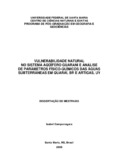| dc.creator | Camponogara, Isabel | |
| dc.date.accessioned | 2007-09-11 | |
| dc.date.available | 2007-09-11 | |
| dc.date.issued | 2006-03-17 | |
| dc.identifier.citation | CAMPONOGARA, Isabel. Natural vulnerability in the Guarani Aquifer System and analysis of physiochemical parameters of the groundwater in Quaraí - BR and Artigas - UY. 2006. 110 f. Dissertação (Mestrado em Geociências) - Universidade Federal de Santa Maria, Santa Maria, 2006. | por |
| dc.identifier.uri | http://repositorio.ufsm.br/handle/1/9476 | |
| dc.description.abstract | This research was developed with the intention of understanding the aquifer dynamics and the underground spring s preservation. In that sense, it was had as main objective to study the natural vulnerability of the Guarani Aquifer System and to analyze physiochemical parameters of the groundwater in the cities of Quaraí - Brazil and Artigas - Uruguay, due to the exploited waters of this aquifer, they be used mainly for human consumption. This way, it was used for the execution of the study, pré-existent data, field research and computer techniques. The methodology used to study the aquifer natural vulnerability leaned on in the DRASTIC Model. To characterize the groundwater, it was made analysis of physiochemical parameters in samples collected in March of 2005. As more relevant result it was verified the relation to the natural vulnerability of the aquifer in the area, that same varied of vulnerable, very vulnerable and extremely vulnerable classes. For the obtained results of the analyses of the physiochemical parameters, we stand out that the waters were classified in 5 types: CaHCO3, CaMgHCO3Cl, MgHCO3, CaMgHCO3 and CaNaHCO3. However, it is evident the importance of the accomplishment of researches of that nature, because the results can be used to manage groundwater hydrics resources in a maintainable way. On the other hand, it is waited that the obtained information and the applied methodologies in this research can subsidize addressed actions to the integrated administration of the groundwater hydrics resources between Brazil and Uruguay, mainly in the plans of use of the water, in agreement with foreseen on its legislation. | eng |
| dc.format | application/pdf | por |
| dc.language | por | por |
| dc.publisher | Universidade Federal de Santa Maria | por |
| dc.rights | Acesso Aberto | por |
| dc.subject | Vulnerabilidade natural | por |
| dc.subject | Sistema aqüífero Guarani | por |
| dc.subject | Contaminação | por |
| dc.subject | Parâmetros físico-químicos | por |
| dc.subject | Natural vulnerability | eng |
| dc.subject | Guarani aquifer system | eng |
| dc.subject | Contamination | eng |
| dc.subject | Physiochemical parameters | eng |
| dc.title | Vulnerabilidade natural no Sistema Aqüífero Guarani e análise de parâmetros físico-químicos das águas subterrâneas em Quaraí, BR e Artigas, UY | por |
| dc.title.alternative | Natural vulnerability in the Guarani Aquifer System and analysis of physiochemical parameters of the groundwater in Quaraí - BR and Artigas - UY | eng |
| dc.type | Dissertação | por |
| dc.description.resumo | Com o intuito de compreender a dinâmica dos aqüíferos e a preservação dos mananciais subterrâneos é que se propôs desenvolver esta pesquisa. Nesse sentido, teve-se como objetivo principal estudar a vulnerabilidade natural do Sistema Aqüífero Guarani e analisar parâmetros físico-químicos das águas subterrâneas em Quarai, Brasil, e Artigas, Uruguai, devido as águas explotadas deste aqüífero serem utilizadas principalmente para consumo humano. Desta forma, utilizou-se para a execução do estudo, dados pré-existentes, pesquisa de campo e técnicas computacionais. A metodologia empregada para estudar a vulnerabilidade natural dos aqüíferos apoiou-se no Modelo DRASTIC. Para caracterizar as águas subterrâneas, fez-se análise de parâmetros físico-químicos em amostras coletadas em março de 2005. Como resultado mais relevante constatado pode-se destacar, em relação à vulnerabilidade natural dos aqüíferos da área, que a mesma variou de vulnerável, muito vulnerável a extremamente vulnerável. Quanto aos resultados obtidos das análises dos parâmetros físico-químicos, destaca-se que as águas classificaram-se em 5 tipos: CaHCO3, CaMgHCO3Cl, MgHCO3, CaMgHCO3 e CaNaHCO3. Contudo, é evidente a importância da realização de pesquisas dessa natureza, pois os resultados podem ser utilizados para gerenciar de modo sustentável os recursos hídricos subterrâneos, por outro lado, espera-se que as informações obtidas e as metodologias aplicadas nesta pesquisa possam subsidiar ações direcionadas à gestão integrada dos recursos hídricos subterrâneos entre Brasil e Uruguai, principalmente nos planos de uso da água, de acordo com o previsto na legislação de ambos os países. | por |
| dc.contributor.advisor1 | Silva, Jose Luiz Silverio da | |
| dc.contributor.advisor1Lattes | http://lattes.cnpq.br/9689434318472831 | por |
| dc.contributor.referee1 | Mello Filho, José Américo de | |
| dc.contributor.referee1Lattes | http://lattes.cnpq.br/1846519270888528 | por |
| dc.contributor.referee2 | Pinheiro, Rinaldo Jose Barbosa | |
| dc.contributor.referee2Lattes | http://lattes.cnpq.br/1539316781096410 | por |
| dc.creator.Lattes | http://lattes.cnpq.br/8789108062225877 | por |
| dc.publisher.country | BR | por |
| dc.publisher.department | Geociências | por |
| dc.publisher.initials | UFSM | por |
| dc.publisher.program | Programa de Pós-Graduação em Geografia e Geociências | por |
| dc.subject.cnpq | CNPQ::CIENCIAS HUMANAS::GEOGRAFIA | por |


